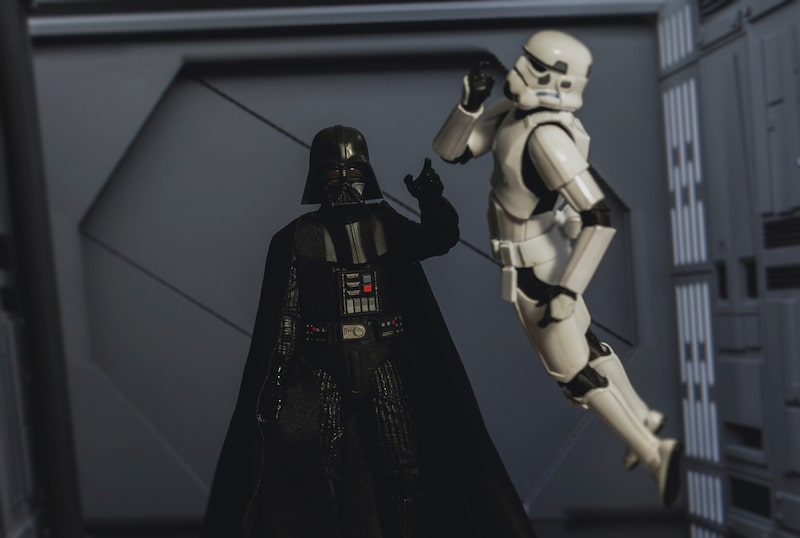Power, anger, and hate defined the Sith. And through passion, they believed they could achieve power and become victorious in their quest to rule the Galaxy. But did they succeed in ruling the Galaxy, and by extension, care about the Galaxy?
Sheev Palpatine was a madman, but plenty of evidence exists that he cared about the Galaxy during his rule from 19 BBY to 4 ABY. He used Sith motivations to achieve power, but he did so in a cunning way.
Table of Contents
Did the Sith Ever Rule the Galaxy?
It’s debatable whether the Sith ruled the Galaxy following the Galactic Republic’s fall in 19 BBY. While the Sith killed off most of the Jedi and ended the Republic, rebellion arose not long after, as seen in Star Wars: Rebels, which began in 5 BBY.
With surviving Jedi plus the new hopes in Luke Skywalker and Leia Organa, the Sith ruled the Galaxy but with an asterisk since they never achieved their goal of ending the Jedi. Nor did they end any potential threat to their rule.
Why Do the Sith Want to Rule the Galaxy?
The Sith craved power, and their code allowed them to achieve their power through passion and strength. And when they achieved their power, the Sith were willing to do anything to maintain it. If it meant killing and collateral damage, so be it.
It was something Sheev Palpatine proved when he ignited the Clone Wars and sent the galaxy into a tailspin.
The Sith also possessed a proper chain of command with a Master and an Apprentice. They believed the Republic’s chain of command was too messy, given the budding cronyism between the Senate and the Jedi.
They wanted to cut out the bond the Jedi formed with the Senate. And thanks to Darth Bane, they accomplished this.
The Sith’s Master would rule until the Apprentice overpowered them. Then, that Apprentice became the Master, who sought an Apprentice, and the process started again.
The Rule of Two allowed the Sith to continue increasing their power through the generations. It occurred when Palpatine killed Darth Plagueis. And it could have occurred again had Darth Vader killed Darth Sidious before recruiting Luke Skywalker to rule the galaxy with him.
And if the Apprentice was not strong enough, the Master killed them off, which occurred when Palpatine told Anakin to get rid of Count Dooku.
The Sith also wanted to become more stable than the Republic. The Phantom Menace provided Palpatine a golden opportunity when Queen Amidala’s ineffective pleading with the Senate for help against the Trade Federation displayed the Republic’s weakness.
While the Republic needed to be prodded to push policy measures through, the Sith did not. They were more effective.
And under their dictatorship, they believed the Galaxy would thrive despite their own corrupt ways. When they wanted to get something done, they got it done. They wanted straightforwardness in the galaxy, and the Republic did not provide that.
The Republic’s Flaws

The Sith also wanted to throw a dagger into the Jedi’s politicizing of the Galaxy in lieu with the Senate. The Sith saw that this wasn’t right regarding what was supposed to be a religious organization.
And while the Sith were no angels, neither were the Jedi during the Galactic Republic’s waning years. Even the latter believed otherwise. The Jedi, despite their Code, threatened with becoming drunk with power considering their political ties.
While the Republic represented democracy and embraced traits like serenity, corruption and backstabbing existed within, and the Jedi let it happen.
Many corrupt actions occurred behind closed doors. One involved Palpatine, despite his true identity as a Sith Lord, controlling the Clone Wars. Palpatine saw the corruption and took advantage.
But the Senate still elected Palpatine. They still embraced him, his policies, and ultimately, his lies.
What Does the Sith Want?
The Sith were power cravers. And it showed before Darth Bane implemented the Rule of Two. One reason he wrote the rule stemmed from weaker Sith gathering their numbers to battle and destroy stronger Sith.
The weaker Sith wanted to be the strongest Force-sensitives in the Sith Order. But in return, the Sith inadvertently weakened, became vulnerable, and collapsed to the Jedi.
To remedy this, Bane instituted the Rule of Two, which systematically allowed for two Sith Lords at any time. The Rule of Two also required both Sith Lords to embrace the dark side before everything.
The Master, or the “embodiment” of the dark side taught the Apprentice, or the “craver,” the ways of the dark side. This allowed the Apprentice to grow stronger than the Master, or die in the effort.
The Master needed to be comfortable dying at their Apprentice’s hands, since Darth Bane intended the Apprentice to outshine the Master. As the process continued, so did the Sith’s rise to power.
What is the Motivation of the Sith?
The Sith’s prime motivators included negative traits like anger and hate. Emotions like fear triggered anger, which later triggered hate, something Jedi Grand Master Yoda warned others about.
Through these motivations, the Sith developed a sense of passion and the will to achieve power. Ultimately, they sought power through the Force, believing that, with power, they achieved victory and liberation.

FAQs:
Did Palpatine Care About the Galaxy?
On the surface, Palpatine looked like the stereotypical madman bent on wielding power regardless of costs.
And while achieving power served as the Sith’s primary motivation with evil intentions to exert control over others, did they, and Palpatine, believe totalitarianism was a necessary evil?
It’s easy to claim Palpatine’s Death Star served as a way to intimidate worlds into compliance since it destroyed Leia Organa’s home world of Alderaan within seconds.
Can one get any more evil than destroying an entire planet with a superweapon? Or was there more to the Death Star than meets the eye?
Sheev Palpatine’s intellect and calmness spurned interest from Darth Plagueis, who possessed similar traits. Palpatine realized he was different from his peers and family, who he believed lacked ambition.
This led to a rift with his family and he ended up killing them to free himself, and fully commit to the dark side. Palpatine possessed foresight, and he displayed the ability to concoct a long-term plan to rule the galaxy.
People with Palpatine’s intellect believed they were naturally fit to rule, so he took action to drive out those standing in his way, like the Jedi and their beloved Republic.
Given his intellect and foresight, perhaps the Death Star and his numerous superweapons were intended to protect the galaxy from interior and exterior threats.
Evidence Palpatine Cared About the Galaxy
While Palpatine sparked the Clone Wars, he didn’t use Galactic civilians in his armies. Instead, he created a clone army to fight Separitist droids. Using clones and droids instead of galactic citizens allowed him to minimize civilian bloodshed.
Palpatine saw the Republic as unstable and full of corruption. While a corrupt figure himself, he also sought Galactic stability, something the Senate and the Jedi failed at.
Then there is the infamous Death Star and Palpatine’s militarization of the Galactic Empire. On the surface, this seems as though he threatened rebelling planets.
But, by militarizing the Empire and resources throughout the Galaxy, it’s easy to argue Palpatine wanted to uphold the stability he believed he brought to the Galaxy as Emperor. And the Death Star helped grant him that stability.
Palpatine also realized there was another threat. One the Jedi Order even knew about. This threat, the Yuuzhan Vong, was an extragalactic species that invaded the New Republic in 30 ABY in Star Wars Legends.
Palpatine realized the Republic would not have fared well against this species, and it’s clear he wanted to protect the Empire from meeting such a sticky fate. Which explains his creation of the Death Star.
Conclusion
The Sith held a thirst for power and they didn’t care about the costs it took to achieve that power. While the Sith ruled the Galaxy from 19 BBY to 4 ABY, they never enjoyed total control given the budding rebellion that picked up in 5 ABY.
While the Sith were power-cravers, they also believed the Republic had become unstable and corrupt. And though corrupt himself, Sheev Palpatine also believed he could bring stability to the Galaxy that the Jedi and the Galactic Senate failed to bring.
Palpatine was evil, and he committed numerous atrocious acts before and after his time as Emperor. But there is evidence he cared about the Galaxy and that some of his so-called sociopathic tendencies really sought to protect and stabilize the Galaxy.


